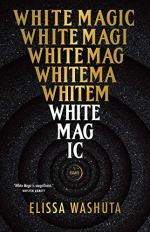|
This section contains 794 words (approx. 2 pages at 400 words per page) |

|
White Magic Summary & Study Guide Description
White Magic Summary & Study Guide includes comprehensive information and analysis to help you understand the book. This study guide contains the following sections:
This detailed literature summary also contains Topics for Discussion on White Magic by Elissa Washuta.
The following version of this novel was used in the creation of this study guide: Washuta, Elissa. White Magic. Tin House. 2021. Hardcover.
The introduction describes the narrator, Elissa Washuta’s love of magic. She is part of the Cowlitz tribe and quit drinking to focus on spells and her ancestors. However, she struggles with severe PTSD and is unable to find a therapist who can help her process the abuse she dealt with in the past. She thinks that she asked for the assaults because she chose her body before she was born and does not feel safe. She wants love more than anything and hopes she can find out the truth about herself in her wounds.
The first essay, "Little Lies," focuses on Washuta’s years of drinking and the pain she has faced. She searches for a D.A.R.E video containing the songs “In the Air Tonight” by Phil Collins and “Little Lies” by Fleetwood Mac. Washuta proceeds to drown in her alcoholism and tries to use drinking to remove her memories of frequent assaults, rape, and other pain. Eventually, she is able to stop drinking and tries to distance herself from her love, Carl, because a relationship with him is toxic. The author also includes studies about drinking in tribes after the arrival of Europeans and how coal miners relied on whisky to purge their lungs of the deadly black soot. Washuta realizes through Stevie Nicks’ music that she needs to find love for herself and discover things willing to live for her.
The second essay, "The Spirit Corridor," discusses Washuta’s beliefs in astrology and witchcraft while briefly introducing her relationships with Carl and Henry. She realizes that she loves trying to solve riddles and dreams even if there are no clear answers. She also tells the stories of her ancestors who worked in the mines and drank to try and dispel the black goo. Her relationship with Carl continues to shift between love and dislike until she realizes she has to let him go when he plans to move away with his new girlfriend.
Essay number three titled “Rocks, Caves, Lakes, Fens, Bogs, Dens, and Shades of Death” discusses the idea that women are often forced to kill themselves to avoid being assaulted. She describes the various locations she has lived throughout the years and the horror movies that were filmed nearby.
The fourth essay, “White City,” is focused heavily on the history of the Duwamish people and the loss of their land that was built into Seattle. The settlers disrupt the land and Washuta blames the abuse she experiences with Henry on the white men’s desire for dominance. The settlers diverted the river to build a canal and ended up draining the Black River which was vital to the tribe’s existence.
The fifth essay titled “Oregon Trail II For Windows 95/98/ME & Macintosh: Challenge the Unpredictable Frontier,” is focused on the second-person narrator’s adventure in the game of the same name and their decisions in real life. The narrative constantly shifts back and forth between the game and reality and the narrator mentions a abusive relationship with Philip and the desire to restart the game and try again once it is done.
Essay number six, titled "Centerless Universe," focuses on Washuta’s research into the Fremont Bridge and its effect on the Duwamish people. The essay is divided between their story and Washuta’s struggles with Carl and her own PTSD.
The seventh essay, “My Heartbreak Workbook”, discusses the self-help book written by Harville Hendrix which helps Washuta comes to terms with her emotional scars and how to rebuild relationships. In the end, Washuta declares that she is independent and will not let men try to fill the hole of her trauma.
The eighth essay “The Spirit Cabinet” is a highly detailed timeline of a few years in Washuta’s life that discusses her struggles to overcome her love for Carl and the unloving relationship with another man named Billy. The reader sees the shift from Washuta’s self-consciousness and personal struggles to a more confident and independent woman who realizes she can be happy on her own. She also includes scenes from the show Twin Peaks as a mirror to her life and various quotes to explain her worldview.
Finally, the last essay, titled “In Him We Have Redemption Through His Blood,” focuses on Washuta’s obsession with the game Red Dead Redemption 2 and how it gives her the chance to separate from her difficult reality and enjoy a fictional world. Washuta says she will work to find happiness in her own life and chooses to replay the game over and over so she does not have to experience the end.
Read more from the Study Guide
|
This section contains 794 words (approx. 2 pages at 400 words per page) |

|



